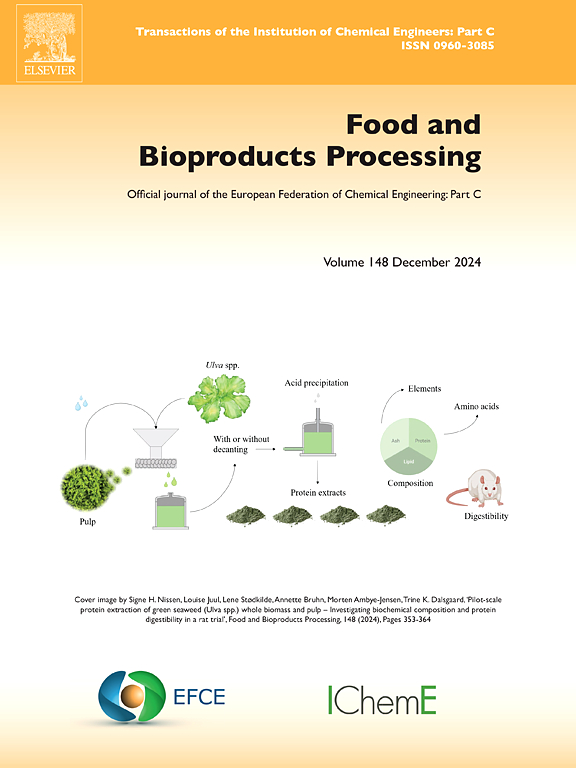肉类生产中范围1和范围2的碳足迹分析。抛光厂的案例研究
IF 3.4
2区 农林科学
Q2 BIOTECHNOLOGY & APPLIED MICROBIOLOGY
引用次数: 0
摘要
对波兰一家大型工业工厂的肉类生产和加工进行了碳足迹(CF)分析。面对日益增长的环境意识和可持续发展报告要求,肉类行业对温室气体(GHG)排放的影响进行了研究。分析的重点是动物原材料的屠宰和加工过程,同时考虑到直接和间接排放(电力、燃料、运输和制冷剂消耗)。收集到的数据使我们有可能制定一种统一的计算CF的方法,涵盖工厂中肉制品的整个生命周期。建立了一个测量系统和数据库,以收集有关排放的关键信息。产猪肉总CF为0.497 kg CO2eq/kg。结果显示了产生最高排放量的地方,从而确定了CF最高的地区和减少的机会。与生产相关的平均温室气体排放主要来自间接排放(电力消耗),屠宰场和加工厂的温室气体排放分别占68% %和70% %。该研究强调了统一标准对分析肉类行业的温室气体排放及其对可持续生产运动的影响的重要性,这对应对气候变化至关重要。已开发的成果允许有意识地管理公司的可持续发展。本文章由计算机程序翻译,如有差异,请以英文原文为准。
Carbon footprint analysis for Scope 1 and 2 in meat production – Case study of polish plants
The carbon footprint (CF) analysis of meat production and processing at a large industrial plant in Poland was carried out. In the face of growing environmental awareness and sustainability reporting requirements, the meat industry's impact on greenhouse gas (GHG) emissions was examined. The analysis focused on the slaughtering and processing processes of animal raw materials, taking into account direct and indirect emissions (electricity, fuel, transportation and refrigerant consumption). The collected data made it possible to develop a uniform methodology for calculating CF, covering the full life cycle of meat products in a plant. A measurement system and database were created to collect key information on emissions. The total CF of pork production was 0.497 kg CO2eq/kg. The results showed where the highest emissions are generated, allowing the identification of areas with the highest CF and opportunities for reduction. Average production-related GHG emissions came mainly from indirect emissions (electricity consumption) and accounted 68 % and 70 % respectively for slaughterhouses and processing plants The study highlights the importance of uniform standards for analyzing the meat industry's CF and their impact on the movement toward sustainable production, which is crucial in the fight against climate change. The developed results allow for conscious management of the company's sustainable development.
求助全文
通过发布文献求助,成功后即可免费获取论文全文。
去求助
来源期刊

Food and Bioproducts Processing
工程技术-工程:化工
CiteScore
9.70
自引率
4.30%
发文量
115
审稿时长
24 days
期刊介绍:
Official Journal of the European Federation of Chemical Engineering:
Part C
FBP aims to be the principal international journal for publication of high quality, original papers in the branches of engineering and science dedicated to the safe processing of biological products. It is the only journal to exploit the synergy between biotechnology, bioprocessing and food engineering.
Papers showing how research results can be used in engineering design, and accounts of experimental or theoretical research work bringing new perspectives to established principles, highlighting unsolved problems or indicating directions for future research, are particularly welcome. Contributions that deal with new developments in equipment or processes and that can be given quantitative expression are encouraged. The journal is especially interested in papers that extend the boundaries of food and bioproducts processing.
The journal has a strong emphasis on the interface between engineering and food or bioproducts. Papers that are not likely to be published are those:
• Primarily concerned with food formulation
• That use experimental design techniques to obtain response surfaces but gain little insight from them
• That are empirical and ignore established mechanistic models, e.g., empirical drying curves
• That are primarily concerned about sensory evaluation and colour
• Concern the extraction, encapsulation and/or antioxidant activity of a specific biological material without providing insight that could be applied to a similar but different material,
• Containing only chemical analyses of biological materials.
 求助内容:
求助内容: 应助结果提醒方式:
应助结果提醒方式:


